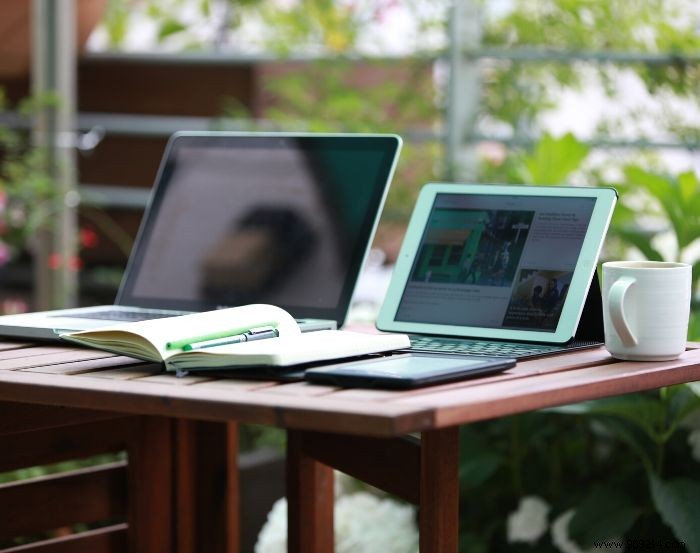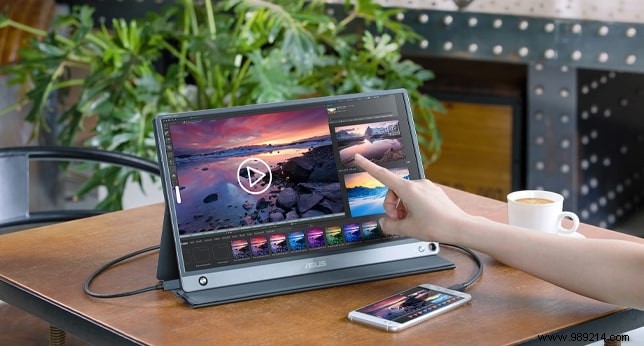A portable monitor helps you stay mobile, easily accomplish other tasks, and expand your screen real estate so you can do so much more in the time you have. It's also packed with great features, takes up less space, and is a good backup when your main screen is down.
ContentsSizeResolution/Display/Contrast ratioWeight/PortabilityEase of use/ConnectivityPowerTouchscreen capabilityDurabilityOther extrasWith the dozens of different designs, sizes, and styles available today, it can be a real chore to find the one that will meet your needs. We will explain in detail what to look for when choosing a portable monitor.
Size is an important factor depending on your needs and lifestyle. Large screens are ideal for presentations and games, while smaller or medium ones are useful for people who travel often or go to school because they are easier to transport. The sweet spot is a mid-size 12-17 inch monitor like the AOC I1601FWUX USB-C Portable Monitor, which is easy to carry when traveling, good for entertainment, and doesn't get damaged easily like larger screens.

Look for an HD screen for sharper images and clearer images and a bezel screen for a higher quality image and edge-to-edge screen. Sub-HD quality screens only provide dull images or images that can tire you out if you use them for long hours.
Anything in Full HD (1920x1080) or similar to your computer's resolution will be great for seamless use and will serve you best over a long period of time.
Check the contrast ratio of the monitor for the highest quality resolution and excellent performance. You can get multiple with 600:1, but 1000:1 is the best recommended ratio and will guarantee you a better display.
Getting the color ratio right is also important, as it affects your experience when viewing or using the monitor. You can change the display to your liking in your display settings or from your keyboard.
A portable monitor should be lightweight so that it is easier to carry in your bag or luggage while supporting your work. It also reduces any strain on your back if you carry it in a backpack.
Check that the features you need in a monitor are the ideal weight, like the Lenovo ThinkVision M14, which is only 1.26 lbs. Not only is it easy to carry, but it also allows you to avoid overweight baggage fees if you travel by plane.
Setting up your portable monitor shouldn't be a chore. To avoid this, look for plug-n-play compatible models so you can easily and quickly connect to your laptop (preferably with a standard USB-C port) and use it. This way you can also pack lighter as you won't need to carry too many long and bulky cables for your monitor.

Check the ports on the monitor and make sure they match those on your computer/laptop. If they don't fit, you may need to purchase an adapter.
Ideally, a portable monitor with a UDMI port is considered a universal port and is effective in terms of connecting your laptop to other displays.
Newer models have USB Type-A and Type-C ports like the ASUS MB169C+, which offers the high-resolution display you need, but Type-C is more powerful and much faster, as it can charge your monitor faster while providing a quality display.
Additional ports like HDMI and headphone ports are useful for entertainment purposes like listening to music, gaming or watching videos and movies.
A portable monitor should come with a built-in battery of at least 5000 mAh for efficiency, so you can use it away from a power outlet for a good period of time.

It should also use minimal power so you can have more time to use it, especially in the event of a power outage, and to extend battery life. Look for a lithium-ion battery powered monitor, as these batteries are small but have high voltage handling capability.
Also check the power source to see if you can charge the monitor using a USB cable. Otherwise, you'll have a harder time finding ways to power it, since it can't charge from your laptop.
The touchscreen is often touted as an optional feature for a portable monitor. If you need one, you should look for one with a touchscreen.
A portable monitor with a touchscreen can be more expensive than others and also consumes more power. Decide if you need touchscreen functionality before shopping.

The market may not be as big right now, but there are still some good options to choose from if you want a portable monitor with touchscreen support. A good example is the Asus ZenScreen Touch (MB16AMT), whose screen supports 10-point capacitive multi-touch input so you can use standard finger-based touch gestures like scrolling, stretching or the pinch to control it. It also has a stylus whose flexible end allows you to scroll and tap links and has other touch functions as well.
The portable monitor you choose should be durable as it will spend most of its time in different types of bags and you want to protect it from bumps, breaks or scratches. You can get a protective cover, although many models come as an extra. Get a spare protector if you want even more protection.
High quality sound is good for gaming, watching movies, video or Zoom meetings and more. Look for a portable monitor with a high-quality speaker system that can adjust the volume up and down.

The auto-rotate orientation is another added benefit as it helps you use the monitor for all sorts of tasks. Some portable monitors also come with foldable stands to support the monitor and serve as protective covers for the screen.
We hope you now know what to look for when choosing a portable monitor. The brand is not an issue, nor is the price, as it is not the best way to determine the value of the monitor. Happy shopping!